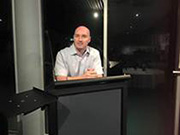Hot Topic Blog - Oral/Pharyngeal Sensory-Motor, Orofacial Myofunctional, & Airway Information
HOW A BLOCKED NOSE LEADS TO A BROKEN HEARTBy David McIntosh; MBBS, FRACS, PhD; Paediatric ENT Specialist; Associate Professor, James Cook University in AustraliaOctober 2016 |
|||
|
When we breathe, we draw oxygen-rich air into our lungs. The lungs sit inside the chest which is like a basket made of bones and muscles. The main muscles are the one at the very bottom of the basket called the diaphragm and the muscles between the ribs and coming down from the neck. The part of the lungs that air goes to varies with your breathing pattern. Breathing through the nose leads to more air going to the bottom of the lungs, whilst breathing through the mouth leads to more air going to the top of the lungs. The reason for this is breathing through the nose tends to use the diaphragm muscles more than the chest wall muscles. When you use your diaphragm to breathe, it opens up the bottom part of your lungs. When you use your chest wall muscles, it opens up the top part. OK. So, the next thing to understand is that to get the oxygen into our body, we need the oxygen to flow into the blood stream. And, this is the job of the lungs - to get the air up close and personal with the red blood cells in the lungs and get them to take the oxygen away into the body. Now, when we are upright, more blood flows through the bottom of our lungs than the top - this is just simple gravity. So, think about this for a moment - breathe through your nose. More air goes into the bottom of the lungs where there is more blood flowing through when breathing through your nose, so things are in balance. Breathe through your mouth, and more air is up at the top of the lungs, away from the blood supply, so less oxygen goes into the blood stream. This is hopefully simple enough so far, but here is the kicker - the blood vessels can detect that there is less oxygen in the lungs and they react by closing down - we call this vasoconstriction. When blood vessels constrict, it means the blood will have a harder time flowing through them. This also means the pressure within the blood vessels rises. This causes a back pressure build-up, all the way to the heart. And, this build-up in pressure means the heart has to work harder to move the blood around. The problem is the heart has a limited capacity to cope with this increased workload, and it can start to fail. High blood pressure in the lungs is called pulmonary hypertension. And, when the heart fails due to this high blood pressure, it is called cor pulmonale. Fortunately the latter rarely happens. But, pulmonary hypertension is a different story. Have a guess. How often do you think a kid with big adenoids blocking the nose, or a kid with hay fever blocking the nose, or a kid with a deviated nasal septum blocking the nose will have pulmonary hypertension? Had a guess? Did you say 1 in 5? Because, that is the answer. That’s right - 1 in 5 or 20% of kids with big adenoids have been found in research studies to have pulmonary hypertension. This is a really dangerous form of high blood pressure. And, to add insult to injury, remember how I said mouth breathing kids end up with low oxygen levels? Think that is good for their brain? Of course it’s not. Kids with mouth breathing, snoring, and sleep apnoea are prone to learning, behavioural, emotional, and a multitude of other health problems. Please know this: kids are not supposed to snore more than 4 nights of the week. And, some may not snore simply because they are bypassing the obstruction by breathing through their mouths. But, this is not good either. Do not be dismissed as a paranoid parent - the research is out there to support the role of natural breathing and the first-line of treatment is seeing a paediatric ENT who manages this sort of thing on a regular basis. Here are some other resources you may be interested in reading: http://www.ncbi.nlm.nih.gov/m/pubmed/24969347/?i=7&from=adenoid%20pulmonary%20hypertension http://www.ncbi.nlm.nih.gov/m/pubmed/23245625/?i=8&from=adenoid%20pulmonary%20hypertension http://www.ncbi.nlm.nih.gov/m/pubmed/22647560/?i=9&from=adenoid%20pulmonary%20hypertension About the Author Associate Professor Dr. David McIntosh of ENT Specialists Australia was kind enough to write this month’s blog. David also contributes to Facebook groups collaborating with other specialists who manage breathing problems in kids. They talk about mouth breathing, and David contributes amazing knowledge about how mouth breathing can lead to serious heart problems. David has kindly contributed this blog in the hope that parents will take a more proactive role in finding breathing problems in their own children and insist doctors take their concerns seriously.
David is a Paediatric ENT Specialist with a particular interest in airway obstruction, facial and dental development and its relationship to ENT airway problems, and middle ear disease. He also specialises in sinus disease and provides opinions on the benefit of revision of previous sinus operations. He is passionate about Indigenous Health. And, he has undertaken advanced surgical training in ENT and Head and Neck Surgery and Paediatric training at Starship Children's Hospital in Auckland, New Zealand. He is the author of Snored to Death: Are you dying in your sleep? Contact Information: |
|||
 Breathing - it’s a crucial aspect to life. We all know we need to do it. And, we do it every day until our last breath. But most people are unaware that breathing through the nose or mouth makes a difference between health and illness. This blog is not intended to be medical advice and should not be relied upon as such, but it is a statement of fact when it comes to physiology. So, it’s a good place to start for enquiring minds.
Breathing - it’s a crucial aspect to life. We all know we need to do it. And, we do it every day until our last breath. But most people are unaware that breathing through the nose or mouth makes a difference between health and illness. This blog is not intended to be medical advice and should not be relied upon as such, but it is a statement of fact when it comes to physiology. So, it’s a good place to start for enquiring minds.